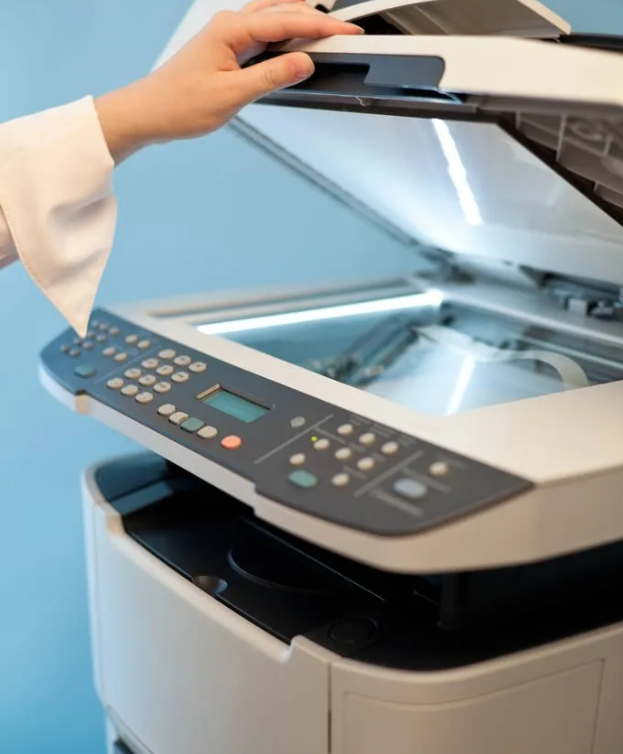One of the most common faults when using copiers is paper jams. If you want to solve paper jams, you must first understand the cause of paper jams.
Causes of paper jams in copiers include:
1. Separation finger claw wear
If the copier is used for a long time, the photosensitive drum or the fuser separation claws of the machine will be severely worn, resulting in paper jams. In severe cases, the separation claws cannot separate the copy paper from the photosensitive drum or the fuser, causing the paper to wrap around it and cause a paper jam. At this time, use absolute alcohol to clean the toner on the fixing roller and the separation claw, remove the blunt separation claw, and sharpen it with fine sandpaper, so that the copier can generally continue to be used for some time. If not, only replace the new separation claw.
2. Paper path sensor failure
Paper path sensors are mostly located in the separation area, the paper outlet of the fuser, etc, and use ultrasonic or photoelectric components to detect whether the paper passes or not. If the sensor fails, the passing of the paper cannot be detected. When the paper is advancing, when it touches the small lever transported by the sensor, the ultrasonic wave or light is blocked, so that it is detected that the paper has passed, and an instruction to proceed to the next step is issued. If the small lever fails to rotate, it will prevent the paper from advancing and cause a paper jam, so check whether the paper path sensor works correctly.
3. Parallel mixed wear and drive clutch damage
Alignment mixing is a hard rubber stick that drives the paper forward for alignment after the copier paper is rubbed out of the carton, and is located on the upper and lower sides of the paper. After the alignment is worn out, the paper’s advance speed will be slowed down, and the paper will often get stuck in the middle of the paper path. The drive clutch of the alignment mixer is damaged so that the mixer cannot rotate and the paper cannot pass through. If this happens, replace the alignment wheel with a new one or deal with it accordingly.
4. Exit baffle displacement
The copy paper is output through the exit baffle, and a copy process is completed. For copiers that have been used for a long time, the outlet baffles sometimes shift or deflect, which prevents the smooth output of copy paper and causes paper jams. At this time, the exit baffle should be calibrated to make the baffle straight and move freely, and the paper jam fault will be resolved.
5. Fixing pollution
The fixing roller is the driving roller when the copy paper passes through. The toner melted by the high temperature during fixing is easy to contaminate the surface of the fixing roller (especially when the lubrication is poor and the cleaning is not good) so that the complex
Printed paper sticks to the fuser roller. At this time, check whether the roller is clean, whether the cleaning blade is intact, whether the silicone oil is replenished, and whether the cleaning paper of the fixing roller is used up. If the fixing roller is dirty, clean it with absolute alcohol and apply a little silicone oil on the surface. In severe cases, the felt pad or cleaning paper should be replaced.
Eight tips for avoiding paper jams in copiers
1. Copy the paper selection
The quality of copy paper is the chief culprit of paper jams and the service life of copiers. It is best not to use paper with the following phenomena:
a. The same package paper has uneven thickness and size and even has defects.
b. There is stubble on the edge of the paper,
c. There are too many paper hairs, and a layer of white flakes will be left after shaking on a clean table. Copy paper with too much fluff will cause the pickup roller to be too slippery so that the paper cannot be picked up, which will speed up the photosensitive
Drum, fuser roller wear, and so on.
2. Choose the nearest carton
The closer the paper is to the photosensitive drum, the shorter the distance it travels during the copying process, and the less chance of “paper jam”.
3. Use the carton evenly
If the two cartons are next to each other, they can be used alternately to avoid paper jams caused by excessive wear of the pickup system of one paper path.
4. Shaking paper
Shake the paper on a clean table and then rub it repeatedly to reduce paper hands.
5. Moisture-proof and anti-static
The damp paper is deformed after being heated in the copier, causing “paper jam”, especially when double-sided copying. In autumn and winter, the weather is dry and prone to static electricity, copy paper often
Two or two sheets stick together, causing a “jam”. It is recommended to place a humidifier near the copier.
6. Clean
If the “paper jam” phenomenon that the copy paper cannot be picked up often occurs, you can use a piece of wet absorbent cotton (do not dip too much water) to wipe the paper pickup wheel.
7. Edge elimination
When copying originals with a dark background, it often causes the copy to be stuck in the paper outlet of the copier like a fan. Using the edge erasing function of the copier can reduce the probability of “paper jam”.
8. Regular maintenance
Comprehensive cleaning and maintenance of the copier is the most effective means to ensure the copying effect and reduce “paper jam”.
When a “paper jam” occurs in the copier, please pay attention to the following points when picking up paper:
1. When removing the “jam”, only the parts that are allowed to move in the copier manual can be moved.
2. Take out the whole paper at one time as much as possible, and be careful not to leave the broken pieces of paper in the machine.
3. Do not touch the photosensitive drum, so as not to scratch the drum.
4. If you are sure that all the “paper jams” have been cleared, but the “paper jam” signal still does not disappear, you can close the front cover again, or switch the power of the machine again.
Post time: Dec-16-2022







